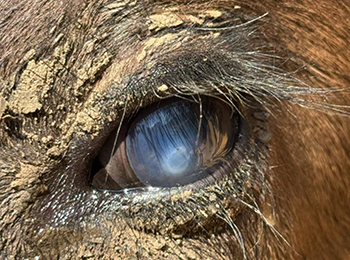Prevention is key to avoiding pinkeye after pasture turnout
5/20/25
AMES, Iowa – As herds are being turned out on pasture across the state, most calves will get an immunity boost for select diseases through a vaccination program. However, as Iowa State University extension beef specialist Chris Clark explained, “Arguably the most common health nuisance on pasture, pinkeye, doesn't have an easy vaccine solution with consistent efficacy. In part, this is because pinkeye is complicated, involving multiple bacterial strains and risk factors.”
The solution? Prevention, prevention, and early intervention.
Prevention points
- Reduce corneal irritants. The cornea provides a protective layer over the eye, and when it is healthy, bacteria cannot attach. Irritants that damage the cornea allow bacteria to colonize and infection to occur. Common irritants on pasture include UV light, seedheads, and dust.
- Control fly populations. Flies contribute to cornea irritation, but the primary role of flies in regard to pinkeye is carrying the bacteria from one animal to the next, and facilitating transmission. Because flies can travel distances, the adage "your fly control program is only as good as your neighbor’s" bears truth. But by taking steps in your herd, populations can still be significantly reduced. Multifaceted approaches are the most effective.
- Prioritize nutrition. Multiple macronutrients and micronutrients are essential for an effective immune response. A well-balanced mineral program is important in keeping the herd healthy. Mineral supplements can become costly, so a solid understanding of mineral levels in the available feed and water can help reduce some costs without sacrificing animal performance.
Early intervention
- Check cattle regularly and watch closely for early signs of infection. Once clinical signs are observed, initiate treatment as soon as possible to minimize complications and severe cases.
- Treat with systemic antibiotics labeled for pinkeye and be diligent in following label directions. Weigh animals to ensure appropriate dosing. Use good injection site practices to ensure optimal drug absorption.
- Adjunct therapy such as eye patches, stitching eyelids shut, and subconjunctival injections are sometimes used in addition to systemic antibiotics. Evidence is somewhat inconsistent regarding efficacy of these practices. Eye patches have been shown to speed corneal ulcer healing, but for best results, leave a spot open to facilitate drainage and airflow when applying. Pinkeye increases sensitivity to UV light, so shade can be helpful for animal comfort. Pain associated with pinkeye may warrant the use of an anti-inflammatory as well. Topical ointments and sprays are also sometimes used.
“As with all health challenges, work closely with your veterinarian to develop a plan for dealing with cases,” Clark said. “Before using any medications, talk with your veterinarian about safety and legality for use in the eye, required dosing schedules, and required withdrawal times.”
-30-
The Iowa Beef Center at Iowa State University was established in 1996 with the goal of supporting the growth and vitality of the state’s beef cattle industry. It comprises faculty and staff from Iowa State University Extension and Outreach, College of Agriculture and Life Sciences and College of Veterinary Medicine, and works to develop and deliver the latest research-based information regarding the beef cattle industry. For more information about IBC, visit www.iowabeefcenter.org.
Contact:
Chris Clark, Iowa State University extension beef specialist, 712-250-0070, caclark@iastate.edu

